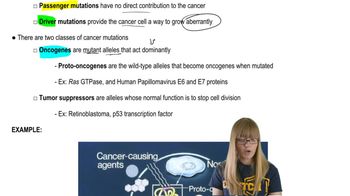Table of contents
- 1. Introduction to Genetics51m
- 2. Mendel's Laws of Inheritance3h 37m
- 3. Extensions to Mendelian Inheritance2h 41m
- 4. Genetic Mapping and Linkage2h 28m
- 5. Genetics of Bacteria and Viruses1h 21m
- 6. Chromosomal Variation1h 48m
- 7. DNA and Chromosome Structure56m
- 8. DNA Replication1h 10m
- 9. Mitosis and Meiosis1h 34m
- 10. Transcription1h 0m
- 11. Translation58m
- 12. Gene Regulation in Prokaryotes1h 19m
- 13. Gene Regulation in Eukaryotes44m
- 14. Genetic Control of Development44m
- 15. Genomes and Genomics1h 50m
- 16. Transposable Elements47m
- 17. Mutation, Repair, and Recombination1h 6m
- 18. Molecular Genetic Tools19m
- 19. Cancer Genetics29m
- 20. Quantitative Genetics1h 26m
- 21. Population Genetics50m
- 22. Evolutionary Genetics29m
19. Cancer Genetics
Cancer Mutations
Problem 14
Textbook Question
Of the two classes of genes associated with cancer, tumor-suppressor genes and oncogenes, mutations in which group can be considered gain-of-function mutations? In which group are the loss-of-function mutations? Explain.
 Verified step by step guidance
Verified step by step guidance1
Identify the two classes of genes associated with cancer: tumor-suppressor genes and oncogenes.
Understand that oncogenes are typically associated with gain-of-function mutations. These mutations lead to the activation of genes that promote cell growth and division, even when they shouldn't be active.
Recognize that tumor-suppressor genes are associated with loss-of-function mutations. These mutations result in the inactivation of genes that normally inhibit cell growth and division, leading to uncontrolled cell proliferation.
Explain that gain-of-function mutations in oncogenes can lead to cancer by causing cells to divide uncontrollably, as these genes are often involved in signaling pathways that regulate cell growth.
Clarify that loss-of-function mutations in tumor-suppressor genes contribute to cancer by removing the normal regulatory mechanisms that prevent excessive cell division, allowing cells to grow unchecked.
Recommended similar problem, with video answer:
 Verified Solution
Verified SolutionThis video solution was recommended by our tutors as helpful for the problem above
Video duration:
2mPlay a video:
Was this helpful?
Key Concepts
Here are the essential concepts you must grasp in order to answer the question correctly.
Oncogenes
Oncogenes are mutated forms of normal genes (proto-oncogenes) that promote cell growth and division. Gain-of-function mutations in oncogenes lead to increased activity, resulting in uncontrolled cell proliferation, which can contribute to cancer development. Examples include mutations in the RAS gene, which can drive tumorigenesis by continuously signaling for cell division.
Recommended video:
Guided course

Cancer Mutations
Tumor-Suppressor Genes
Tumor-suppressor genes are responsible for regulating cell growth and preventing tumor formation. Loss-of-function mutations in these genes result in a decrease or complete loss of their protective effects, allowing cells to grow uncontrollably. A well-known example is the TP53 gene, which encodes a protein that helps prevent the proliferation of cells with damaged DNA.
Recommended video:
Guided course

Mapping Genes
Mutations in Cancer Genetics
Mutations in cancer genetics can be classified into gain-of-function and loss-of-function categories. Gain-of-function mutations enhance the activity of oncogenes, promoting cancer, while loss-of-function mutations in tumor-suppressor genes diminish their ability to control cell growth. Understanding these mutations is crucial for developing targeted cancer therapies and interventions.
Recommended video:
Guided course

Cancer Mutations

 4:50m
4:50mWatch next
Master Cancer Mutations with a bite sized video explanation from Kylia Goodner
Start learningRelated Videos
Related Practice

